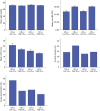Lower diffusing capacity with chronic bronchitis predicts higher risk of acute exacerbation in chronic obstructive lung disease
- PMID: 27293847
- PMCID: PMC4885959
- DOI: 10.21037/jtd.2016.04.66
Lower diffusing capacity with chronic bronchitis predicts higher risk of acute exacerbation in chronic obstructive lung disease
Abstract
Background: This study was designed to evaluate the effect of chronic bronchitis (CB) symptoms and degree of emphysema in a multicenter Korean cohort.
Methods: From April 2012 to May 2015, patients diagnosed with chronic obstructive lung disease (COPD) who were aged above 40 years at 46 hospitals throughout Korea were enrolled. All of the patients were classified according to CB symptoms and the diffusing capacity of the lung for carbon monoxide (DLCO); demographic data, symptom scores, and the result of lung function tests and exacerbations were then analyzed.
Results: A total of 812 patients were enrolled. Among these patients, 285 (35.1%) had CB symptoms. A total of 51% of patients had high DLCO without CB symptoms [CB (-) high DLCO], 24.9% had CB symptoms only [CB (+) high DLCO], 14.2% had low DLCO only [CB (-) low DLCO], and 10.2% had both low DLCO and CB [CB (+) low DLCO]. Patients with CB (+) low DLCO showed a significantly lower post-bronchodilator (BD) forced expiratory volume for 1 second (FEV1) and more severe dyspnea than patients with CB (-) high DLCO. On multivariate analysis, the risk of acute exacerbation was two times higher [odds ratio (OR) 2.06; 95% confidence interval (CI): 1.18-3.62; P=0.01] in the CB (+) low DLCO group than in the CB (-) high DLCO group.
Conclusions: In this COPD cohort, patients showed distinct clinical characteristics and outcomes according to the presence of CB and degree of DLCO. CB and low DLCO were associated with the risk of acute exacerbation.
Keywords: Chronic bronchitis (CB); acute exacerbation; chronic obstructive lung disease (COPD); diffusing capacity.
Conflict of interest statement
Figures
Similar articles
-
Prognostic marker for severe acute exacerbation of chronic obstructive pulmonary disease: analysis of diffusing capacity of the lung for carbon monoxide (DLCO) and forced expiratory volume in one second (FEV1).BMC Pulm Med. 2021 May 6;21(1):152. doi: 10.1186/s12890-021-01519-1. BMC Pulm Med. 2021. PMID: 33957906 Free PMC article.
-
Comparison of clinical characteristics between chronic bronchitis and non-chronic bronchitis in patients with chronic obstructive pulmonary disease.BMC Pulm Med. 2022 Feb 20;22(1):69. doi: 10.1186/s12890-022-01854-x. BMC Pulm Med. 2022. PMID: 35184738 Free PMC article.
-
Diffusing capacity in chronic obstructive pulmonary disease assessment: A meta-analysis.Chron Respir Dis. 2021 Jan-Dec;18:14799731211056340. doi: 10.1177/14799731211056340. Chron Respir Dis. 2021. PMID: 34855516 Free PMC article.
-
Health-related QOL in acute exacerbations of chronic bronchitis and chronic obstructive pulmonary disease: a review of the literature.Pharmacoeconomics. 2005;23(4):345-63. doi: 10.2165/00019053-200523040-00005. Pharmacoeconomics. 2005. PMID: 15853435 Review.
-
Pulmonary hypertension in chronic lung diseases.J Am Coll Cardiol. 2013 Dec 24;62(25 Suppl):D109-16. doi: 10.1016/j.jacc.2013.10.036. J Am Coll Cardiol. 2013. PMID: 24355635 Review.
Cited by
-
Diffusing capacity as an independent predictor of acute exacerbations in chronic obstructive pulmonary disease.Sci Rep. 2024 Feb 5;14(1):2936. doi: 10.1038/s41598-024-51593-8. Sci Rep. 2024. PMID: 38316813 Free PMC article.
-
The association between transfer coefficient of the lung and the risk of exacerbation in asthma-COPD overlap: an observational cohort study.BMC Pulm Med. 2022 Jan 12;22(1):22. doi: 10.1186/s12890-021-01815-w. BMC Pulm Med. 2022. PMID: 35016668 Free PMC article.
-
The clinical efficacy of AG NPP709 (Synatura®) in patients with chronic bronchitis type stable chronic obstructive pulmonary disease.J Thorac Dis. 2020 May;12(5):2435-2442. doi: 10.21037/jtd.2020.03.61. J Thorac Dis. 2020. PMID: 32642149 Free PMC article.
-
Fixed-Dose Combinations of Long-Acting Bronchodilators for the Management of COPD: Global and Asian Perspectives.Adv Ther. 2019 Mar;36(3):495-519. doi: 10.1007/s12325-019-0893-3. Epub 2019 Feb 11. Adv Ther. 2019. PMID: 30742242 Free PMC article.
-
The Prognostic Performance of Lung Diffusing Capacity in Preserved Ratio Impaired Spirometry: An Observational Cohort Study.Int J Chron Obstruct Pulmon Dis. 2022 Oct 28;17:2791-2799. doi: 10.2147/COPD.S384074. eCollection 2022. Int J Chron Obstruct Pulmon Dis. 2022. PMID: 36339246 Free PMC article.
References
-
- Global initiative for Chronic Obstructive Lung disease. Global strategy for the diagnosis, management and Prevent of chronic obstructive pulmonary disease, updated 2014. Available online: http://www.goldcopd.org/
LinkOut - more resources
Full Text Sources
Other Literature Sources
Miscellaneous


